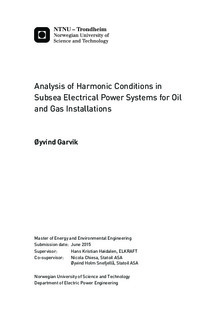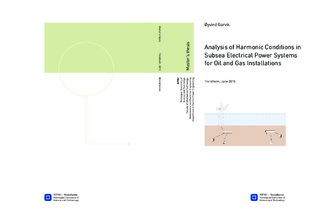| dc.description.abstract | Models of two separate network topologies are developed in cooperation with Statoil ASA to assure realistic construction of the networks along with relevant scenarios. The networks are implemented, simulated and thoroughly analyzed, utilizing the simulation software DIgSILENT PowerFactory 15.1. Simulation scripts have been developed utilizing the DIgSILENT Programming Language. These scripts are used to scan through a wide range of cable lengths to reveal possible trends, patterns or relations in the network topologies' harmonic behavior. Further, two case studies are investigated for each of the network topologies, where the first is a worst-case scenario, and the second is a lower-level THD variant. For the latter case, possible means to assure acceptable THD levels are discussed.
From the simulation results, problematic cable lengths and system limitations are revealed for both network topologies. The severity and potential hazardousness of the separate harmonic components are identified. In addition, limitations with respect to rectifier type utilized in the subsea variable speed drives, which are the harmonic current sources in the networks, are identified.
The two network topologies under consideration have some major constructional differences. How these differences affects the harmonic currents and their manifestation as harmonic voltages, are investigated. It has been found that the presence of a subsea step-down transformer has a substantial effect on how the harmonic currents behave. In addition, each cable's influence on the system's harmonic behavior is very influenced by the presence (or absence) of such a subsea transformer. With a subsea step-down transformer, more or less "local" resonances leads to powerful harmonic current amplifications in the subsea distribution system. The harmonic currents spreads throughout the system, causing increased harmonic voltages. Without a subsea step-down transformer, resonances in the long step-out cable is most problematic, when it comes to harmonic content. Possible resonances are then determined by the most dominant (i.e. the longest) cable. Further, this gives limitations to possible simplifications to be done when modeling and studying harmonics in similar subsea power systems. Generally, a long step-out cable and very short subsea distribution cables are beneficial when it comes to minimizing harmonic voltage content. In addition, naturally formed low-pass filters have substantial damping effects on the harmonics.
If has been found that the utilized theoretical harmonic current spectrum of 12-pulse rectifiers most likely is a too conservative simplification. The quantitative credibility of the simulation results are therefore questionable. However, the qualitative analysis of the thesis should present valuable results and observations.
Most of the results presented in the following do focus on the total harmonic distortion (THD) of the system voltages, network impedances and harmonic current- and voltage spectra. Throughout the analysis, it is aimed to explain the connection between these results, as well as the physical phenomena they are caused by. | |

